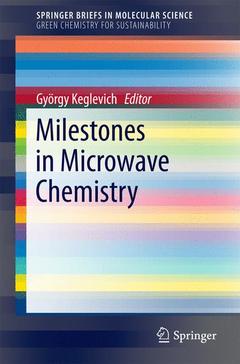Milestones in Microwave Chemistry, 1st ed. 2016 SpringerBriefs in Green Chemistry for Sustainability Series
Coordonnateur : Keglevich György

This book looks back on thirty-five years of microwave (MW) chemistry and explains how the application of the MW technique became an integral part of R&D, eventually becoming recognized in industry. Further, it details how MW chemistry has undergone a dynamic development in the past three decades, one driven by the advent of increasingly sophisticated professional MW reactors in place of the kitchen MW ovens used in earlier years. A major part of the book shows how substitutions, esterifications, amidations, hydrolyses, alkylations, eliminations, dehydrations, condensations, cyclizations, C?C couplings and the modification of heterocycles can be performed advantageously under MW irradiation, as the reaction times are shorter, while the selectivity and yields are higher; it also explains why in most cases, the reactions can be performed under solvent-free conditions. MW irradiation within the sphere of organophosphorus chemistry is showcased and typical reactions, such as the direct derivatization of phosphinic acids, alkylating esterifications, Diels?Alder reactions, the inverse Wittig-type reaction, fragmentations, the Arbuzov reaction, the synthesis of ?-hydroxyphosphonates and ?-aminophosphonates (the Kabachnik?Fields condensation), deoxygenations and P?C coupling reactions are described under MW conditions. In closing, the advantages of MW chemistry such as faster reactions and the possibility of simplifying the catalytic systems are addressed.
The Spread of the Application of the Microwave Technique in Organic Synthesis.- Microwave-Assisted Sytheses in Organic Chemistry.- The Use of MW in Organophosphorus Chemistry.- Interpretation of the Effects of Microwaves.
Prof. György Keglevich was born in Budapest (Hungary) in 1957 and graduated from the Technical University of Budapest in 1981 as a chemical engineer. He completed his PhD in 1984 and his “Doctor of Chemical Science” degree in 1994, both in the subject of organophosphorus chemistry. He received his “Dr. Habil.” degree in 1995 and his DSc in 1994. He served as a Research Associate at Duke University (Durham, North Carolina) for more than a year with Professor Louis D. Quin. On two occasions, he was also a Visiting Associate Professor at the University of Massachusetts.
Affiliations:
Prof. Keglevich has worked at the Department of Organic Chemical Technology since 1981, first as a research employee of the Chinoin Pharmaceutical and Chemical Works Ltd and from 1982 as a member of the teaching staff as an Assistant Professor. In 1993, he was appointed Associate Professor. Since 1996, he has been a Full Professor at the Department of Organic Chemical Technology. He has headed said department (renamed the Department of Organic Chemistry and Technology in 2007) since 1999.
Fields of expertise:
Prof. Keglevich has pursued P-heterocyclic research on the subject of ring enlargement of five-membered P-heterocycles and on the utilization of the products so obtained. He has also elaborated the synthesis of a number of families of compounds. Bridged P-heterocycles, precursors of low-coordinated fragments, were synthesized and utilized in phosphorylations. The study on the synthesis and reactivity of aromatic phospholes forms another relevant part of his research. His additional research interests include Diels–Alder reactions, low-coordinated P-fragments, phosphine-transition metal complexes, selective reductions, phosphine-boranes, azacrown ethers with phosphonoalkyl side chains and selective reductions. Recently, he has turned his attention to environmentally friendly syntheses, and environmentally friendly chemistry (green chemistry) now informs
Includes supplementary material: sn.pub/extras
Date de parution : 03-2016
Ouvrage de 110 p.
15.5x23.5 cm


